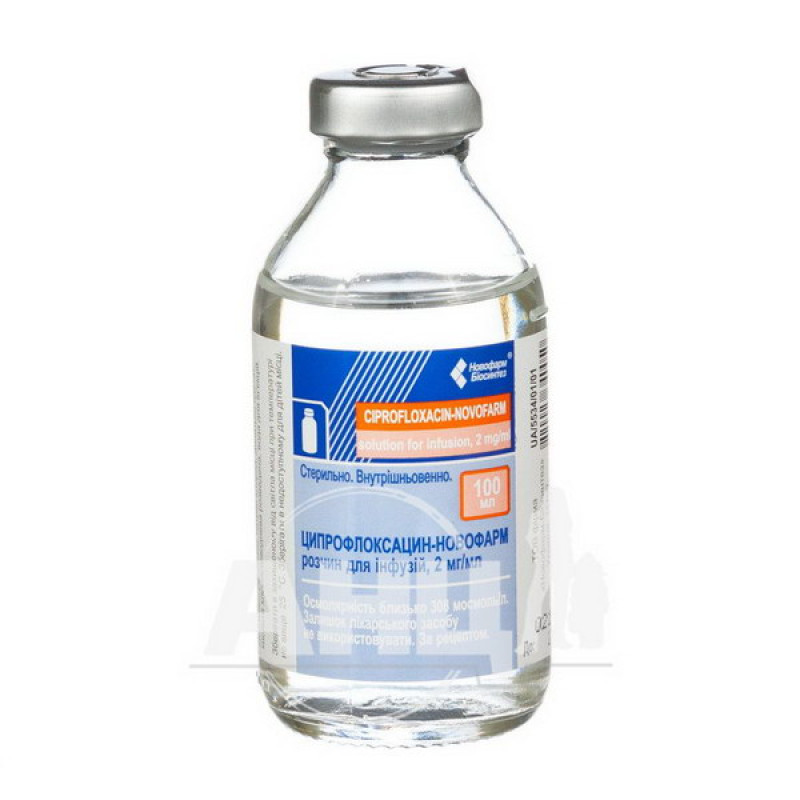Ciprofloxacin-Novopharm solution for infusion 0.2% bottle 100 ml

Ciprofloxacin-Novopharm eliminates uncomplicated and complicated infections caused by pathogens sensitive to ciprofloxacin.
It can be used in children as a second- and third-line drug for the treatment of complicated urinary tract infections and pyelonephritis, as well as for the treatment of pulmonary exacerbations.
Composition
Active ingredient: ciprofloxacin hydrochloride.
One bottle contains ciprofloxacin hydrochloride, calculated as 100% ciprofloxacin, - 200 mg.
Excipients: sodium chloride, sodium edetate, diluted hydrochloric acid, water for injections.
Contraindication
Hypersensitivity to ciprofloxacin or to any component of the drug, as well as to other drugs of the fluoroquinolone group.
Concomitant use of ciprofloxacin-Novopharm and tizanidine due to clinically significant side effects associated with increased plasma concentrations of tizanidine.
Method of application
The dosage regimen is set individually depending on the localization and severity of the infection, as well as the sensitivity of the pathogen.
If oral administration is not possible, it is recommended to start treatment with intravenous administration.
The drug solution can be administered diluted or after adding to other infusion solutions.
Treatment of children with ciprofloxacin should only be prescribed after a careful assessment of the risk-benefit ratio due to the likelihood of side effects on the joints or surrounding tissues.
Application features
Children
As with other drugs in this class, ciprofloxacin has been shown to cause joint arthropathy in immature animals.
An analysis of the available safety data on the use of ciprofloxacin in patients under 18 years of age did not reveal any evidence of treatment-related cartilage or joint damage.
The drug can be used in children only for vital indications.
Pregnant
Ciprofloxacin should not be prescribed to women during pregnancy and breastfeeding, because there is no experience with the use of the drug in these groups of patients, and therefore, based on relevant data obtained in animals, the possibility of damage to articular cartilage in the body cannot be excluded, although it has not developed.
Drivers
The drug may affect reaction speed.
When treating patients, activities that require concentration and quick reactions should be limited.
Overdose
There are no specific symptoms of overdose.
Standard emergency measures are recommended, and hemodialysis and peritoneal dialysis may be additionally performed.
Only a small amount of ciprofloxacin is removed by hemodialysis or peritoneal dialysis.
Side effects
Local reactions have been reported following administration of the drug.
These reactions develop more often if the infusion time is 30 minutes.
They may occur in the form of local skin reactions that resolve quickly after the infusion is finished.
Subsequent infusions of the drug are not contraindicated, unless similar reactions recur or become complicated.
The manifestation of such symptoms:
Nausea, diarrhea, rash, abdominal pain, candidiasis, asthenia, pathological reactions at the injection site, thrombophlebitis at the infusion site, QT prolongation, ventricular arrhythmia, bidirectional ventricular tachycardia, increased levels of hepatic transaminases - AJIT, ACT, alkaline phosphatase, vomiting, dyspepsia, abnormal values of liver function tests, anorexia, flatulence, bilirubinemia, eosinophilia, leukopenia, increased levels of creatinine and urea nitrogen, arthralgia, dizziness, headache, sleep disorders, agitation, confusion, impaired coordination, disorientation, itching, maculopapular rash, urticaria, taste disturbance.
Also with frequency > 0.01% < 0.1%:
Pain in the extremities, back, chest, tachycardia, syncope, vasodilation, arterial hypotension, oral candidiasis, jaundice, cholestatic jaundice, pseudomembranous colitis, anemia, leukopenia, leukocytosis, altered prothrombin levels, thrombocytopenia, thrombocythemia, allergic reactions, serum sickness, naphylactoid reactions, edema, hyperglycemia, myalgia, joint edema, migraine, hallucinations, sweating, paresthesia, anxiety, sleep disorders, convulsions, hyperesthesia, depression, tremor, shortness of breath, laryngeal edema, photosensitization, the appearance of nonspecific bubbles, tinnitus, temporary deafness, visual impairment, diplopia, chromatopsia, loss of taste sensations, acute renal failure, renal dysfunction, vaginal candidiasis, hematuria, crystalluria, interstitial nephritis.
Storage conditions
Shelf life 3 years.
Store at a temperature not exceeding 25 °C.
Keep out of reach of children.
There are no reviews for this product.
There are no reviews for this product, be the first to leave your review.
No questions about this product, be the first and ask your question.



